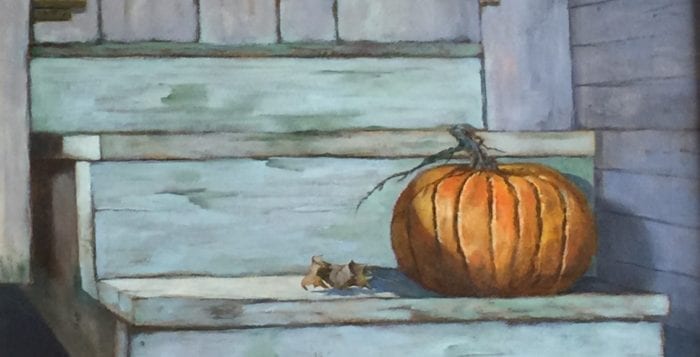Artist of the Month: Al Candia
By Irene Ruddock
Artist’s statement: I hope that my paintings create a deeper sense of the relationship between ourselves and the splendid world in which we live, and are moving through too quickly. — Al Candia

Al Candia, a Stony Brook resident, has been interested in art since childhood. He began painting seriously while teaching English at Commack High School, continuing his studies of art at Stony Brook University. His workshops and private study included courses with many noted artists, including Joseph Reboli. Candia has become an award-winning artist exhibiting extensively in galleries all over Long Island. Chosen as Honored Artist by the Setauket Artists in 2015, Candia is October’s Artist of the Month at The Long Island Museum.
Can you elaborate on your artist’s statement?
I concentrate on the immediate world around me. I try to avoid “grand” subjects and tend to focus on the common, ordinary things that I find meaningful, but that we are sometimes too busy to notice: a farm fence in an open field, ancient beach chairs frozen in the snow, a jetty marching down into the ocean, flowers stuck in an old bucket, a small pumpkin on the steps.
How did you learn to paint?
The most important teacher is “the doing.” I can’t tell you how many acres of canvas I went through to arrive at a level where I began to consider myself as an artist.
It has been said that your paintings ‘touch the heart’ and are soulful. Why do you think that is?
Perhaps by going through life so fast, people might secretly yearn for a simpler way of life. They may enjoy slowing down a bit to “take a breath” and see the ordinary and realize it can be extraordinary.
You were an English teacher for 36 years before becoming a full-time artist. How did teaching influence your work?
For me, there is wonderful connection between fine art and literature. Writers and poets deal very much in the creation of images. An image can haunt us, fill us with joy. It is what makes a written work alive and vivid. It is what made me want to become a painter. I would see something — a broken seashell, a window in the late afternoon shadows — that would move me deeply and would be heavy with meaning. I very much wanted to celebrate that in a painting.

How do you find inspiration for a painting?
Robert Frost said that a poem begins with a lump in the throat. He was talking, of course, about being moved or shaken by something — an idea, an experience, an object — that needs to be expressed. That is true for me also. Recently, I came across a pumpkin on the worn steps of a back porch. I was so taken with this simple object that hardly anyone would see. I thought of the person who placed it there out of a some personal gesture. I thought it would make a touching painting that reveals some small aspect of our humanity.
What is your method?
I usually begin with a bunch of photos. I take these back to my studio and begin to work up a drawing idea for the painting. This is an important step where you design the composition, simplify, arrange the elements, and begin to think of color and light. From there, I proceed as many oil painters do by washing the canvas with a thin mixture of warm color diluted with mineral spirits. Next I begin to lay in the large shapes. Essentially I am carrying on a dialogue with the canvas, finding out what is working and what is not.
Why have you chosen oil painting over other mediums?
I think the medium choose me. It somehow fits my personality. Oil painting is slow moving and deliberate. It often will take a few days to allow the painting to dry before moving on to the next step. During these intervals the painting is percolating in my brain, trying to make the painting as good as it possibly can be. I compare it to a child with a wind up toy, winding that toy as tight as possible in order to release it to its maximum effect.
What is the biggest difficulty you encounter in the creation of a painting?
After working with a painting for a couple weeks, you can lose the sense of it, you lose perspective. You can begin to doubt yourself: did I make all the right decisions, is the color just right, did I overwork it, does it still capture what you set out to do? At this time, for me, it is important to have honest feedback from others. My wife is an important part in keeping me on track.

After all that work and effort, it must be difficult to let a painting go.
Not at all. I love the entire process of painting from the initial moment of finding a subject, to creating a design, through the struggle of execution. And hopefully someone will come along and appreciate the painting enough to buy it and hang it in their home. For me that completes the cycle, and the painting begins its life.
Beside the Visitor’s Center at The Long Island Museum in October, where can we see your work?
I will be exhibiting at the Setauket Neighborhood House in the 37th annual Setauket Artists exhibit from Oct. 22 to Nov. 20. People are always welcome to visit my studio by appointment. You can contact me by visiting my website at www.alcandia.com.







